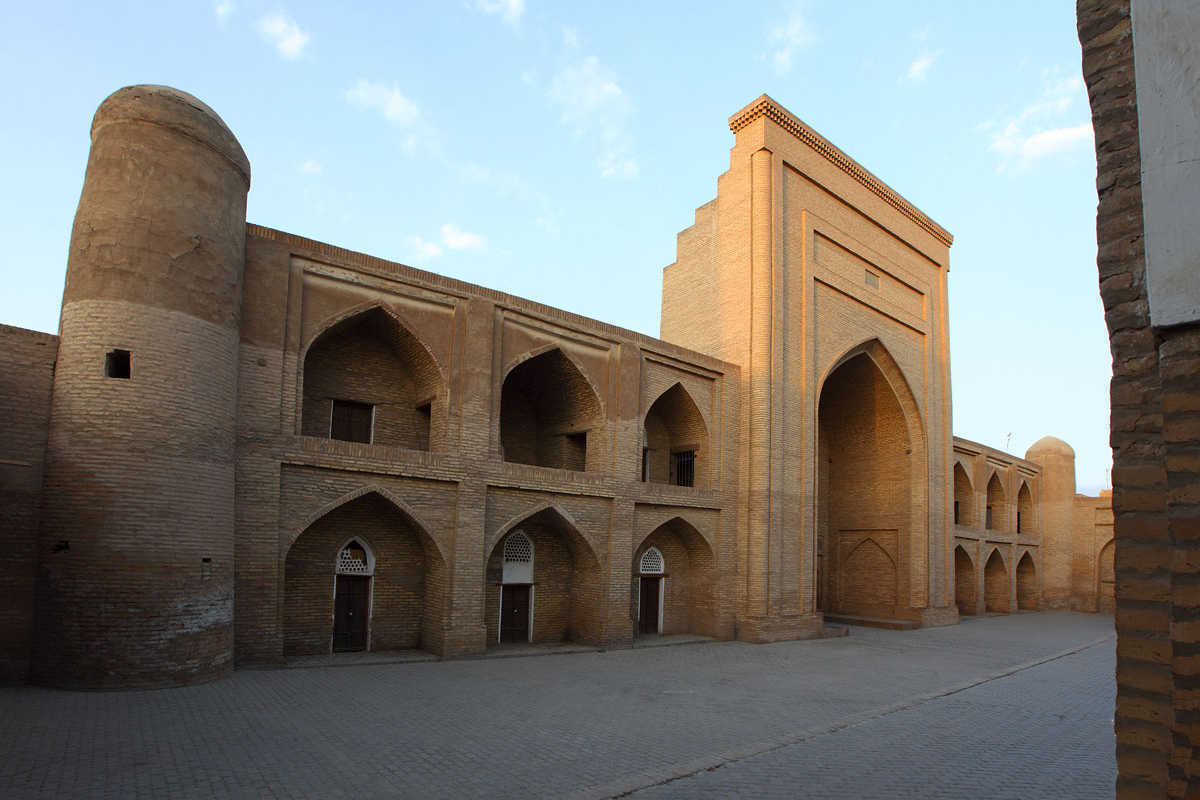Khiva - Shergazi Khan Madrasa
The Shergazi-Khan Madrasa is located in the centre of the historic city of Ichan Kala in Khiva, in front of the entrance to the Pahlavan Mahmud Mausoleum. The Shergazi-Khan Madrasa is one of the oldest and the largest in Khiva. Its entrance is 2 metres below the floor of the street due to natural subsidence and the increase in burial sites.
The madrasa building is single-storey except for a two-storey entrance section and includes a courtyard with four aiwans, a complex of vestibules and an auditorium.

The Shergazi-Khan Madrasa (1719-1726) is the oldest and best known of the remaining educational institutions in Khiva. People who later became famous poets and scientists were educated here.
Therefore, the madrasa was popularly known as “Maskan-i fazilan”, i.e. “abode of the educated”. The talented Uzbek poet Pahlavankuli Ravnak (born 1725) was educated there.
The classic of Turkmen poetry, Makhtumkuli (1733-1793), lived and studied here. The words of sincere gratitude are heard in the poet’s poem dedicated to the graduation of the Shergazi-Khan Madrasa in Khiva:
“Three years you shared salt with me daily,
I’m sorry, I’m leaving, the beautiful Shergazi!
You were my shelter in winter and spring, –
Forgive me, fair Shergazi!
I shall live to know friend from foe,
Truth is now a sacred ally to me;
A golden book has been opened for me here.
Forgive me, I go away, beautiful Shergazi!”
The story of the construction of the madrasa lives in the memory of the people. The Shergazi-Khan Madrasa was built in honour of the conquest of the historical state of Khorasan by the Khan of Khiva, Shergazi.
Shergazi Khan returned from this campaign with a solid trophy, including 5000 prisoners of war. The Khan promised them, in exchange for their freedom, to build a beautiful architectural structure.
Having believed Khan’s words, the prisoners began building the madrasa within three and a half years and finished it in 1726, having put all their skill into it.
However, the conditions were deliberately delayed. The wrath of the slaves was merciless: During one of the visits to the construction, the khan was beheaded. And it is no coincidence that the date of the completion of the madrasa was defined by the poet-historian Muniz with the words: “Ah, save from slaves!” “Dod, az gulomon!” – 1139 г. (1726 A.D.).
Despite considerable repairs at the end of the nineteenth century, the madrasa as a whole was in a distressed and neglected state until the Revolution.
The façade of the madrasa faces the Pahlavan Mahmud complex. The path down the stairs emphasises that it was built much earlier than the surrounding buildings.
The architectural composition of the entire structure is largely in keeping with the traditional madrasa type, with a two-storey main façade with a tall portal in the centre and single-storey buildings around a square courtyard.
There are only 55 hujras here. The portal contains an inscription of historical character proclaiming the conditions for the waqf maintenance of the madrasa. The cleric Beket Ata also graduated from the Shergazi Madrasa.
At that time, one had to have a certain basic knowledge before entering this madrasa, one had to study the Arabic alphabet in the local mosques, learn the Haftiyak, which is a seventh of the Quran, within 2 – 3 years.
